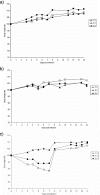Development and evaluation of an Influenza virus subtype H7N2 vaccine candidate for pandemic preparedness
- PMID: 17913860
- PMCID: PMC2168170
- DOI: 10.1128/CVI.00174-07
Development and evaluation of an Influenza virus subtype H7N2 vaccine candidate for pandemic preparedness
Abstract
Influenza virus of the H7N2 subtype has been introduced into noncommercial poultry in the United States, and this probably resulted in incidents of transmission of H7N2 virus to humans, documented in 2002 and 2003. This virus could be considered a potential threat to public health if it acquired person-to-person transmissibility. A favored approach for global pandemic preparedness includes development of prepandemic vaccines for any potential pandemic virus. To this end, we created a high-growth reassortant virus (H7N2-PR8) containing the genes for the hemagglutinin and the neuraminidase from a low-pathogenicity (H7N2) virus strain and the remaining six genes from a human vaccine strain (H1N1). The reassortant strain was evaluated to assess its antigenicity, safety, and protective efficacy using a mouse model. Antigenicity studies using ferret antibodies raised against H7N2-PR8 indicated that this virus confers broad cross-reactivity with divergent H7 viruses of different years and lineages. Mice and chickens inoculated with high doses of H7N2-PR8 supported virus replication but survived, indicating that this virus is comparable to other avian viruses of low pathogenicity. To assess the protective efficacy of H7N2-PR8, mice were immunized with two doses of formalin-inactivated H7N2-PR8, alone or with alum. Vaccinated mice subsequently challenged with highly pathogenic viruses from homologous and heterologous lineages A/Canada/444/04 (H7N3) and A/Netherlands/219/03 (H7N7) showed pronounced reduction of wild-type virus replication. These studies indicate that H7N2-PR8 is immunogenic, safe, and protective in animal models; these are the essential attributes to qualify for phase I human clinical trials as a prepandemic vaccine.
Figures


Similar articles
-
Development of Eurasian H7N7/PR8 high growth reassortant virus for clinical evaluation as an inactivated pandemic influenza vaccine.Vaccine. 2008 Mar 25;26(14):1742-50. doi: 10.1016/j.vaccine.2008.01.036. Epub 2008 Feb 13. Vaccine. 2008. PMID: 18336962
-
Inactivated H7 Influenza Virus Vaccines Protect Mice despite Inducing Only Low Levels of Neutralizing Antibodies.J Virol. 2017 Sep 27;91(20):e01202-17. doi: 10.1128/JVI.01202-17. Print 2017 Oct 15. J Virol. 2017. PMID: 28768855 Free PMC article.
-
Protective efficacy of a high-growth reassortant H1N1 influenza virus vaccine against the European Avian-like H1N1 swine influenza virus in mice and pigs.Vet Microbiol. 2018 Aug;222:75-84. doi: 10.1016/j.vetmic.2018.07.003. Epub 2018 Jul 6. Vet Microbiol. 2018. PMID: 30080677
-
Confronting the avian influenza threat: vaccine development for a potential pandemic.Lancet Infect Dis. 2004 Aug;4(8):499-509. doi: 10.1016/S1473-3099(04)01105-3. Lancet Infect Dis. 2004. PMID: 15288823 Free PMC article. Review.
-
Adenoviral Vectors as Vaccines for Emerging Avian Influenza Viruses.Front Immunol. 2021 Jan 29;11:607333. doi: 10.3389/fimmu.2020.607333. eCollection 2020. Front Immunol. 2021. PMID: 33633727 Free PMC article. Review.
Cited by
-
Optimal designs of an HA-based DNA vaccine against H7 subtype influenza viruses.Hum Vaccin Immunother. 2014;10(7):1949-58. doi: 10.4161/hv.28795. Hum Vaccin Immunother. 2014. PMID: 25424804 Free PMC article.
-
Past, present, and possible future human infection with influenza virus A subtype H7.Emerg Infect Dis. 2009 Jun;15(6):859-65. doi: 10.3201/eid1506.090072. Emerg Infect Dis. 2009. PMID: 19523282 Free PMC article. Review.
-
Glycosylation of Residue 141 of Subtype H7 Influenza A Hemagglutinin (HA) Affects HA-Pseudovirus Infectivity and Sensitivity to Site A Neutralizing Antibodies.PLoS One. 2016 Feb 10;11(2):e0149149. doi: 10.1371/journal.pone.0149149. eCollection 2016. PLoS One. 2016. PMID: 26862918 Free PMC article.
-
A randomized clinical trial of an inactivated avian influenza A (H7N7) vaccine.PLoS One. 2012;7(12):e49704. doi: 10.1371/journal.pone.0049704. Epub 2012 Dec 11. PLoS One. 2012. PMID: 23239968 Free PMC article. Clinical Trial.
-
Broadly protective adenovirus-based multivalent vaccines against highly pathogenic avian influenza viruses for pandemic preparedness.PLoS One. 2013 Apr 30;8(4):e62496. doi: 10.1371/journal.pone.0062496. Print 2013. PLoS One. 2013. PMID: 23638099 Free PMC article.
References
-
- Akey, B. L. 2003. Low-pathogenicity H7N2 avian influenza outbreak in Virginia during 2002. Avian Dis. 47(Suppl.):1099-1103. - PubMed
-
- Banks, J., E. S. Speidel, E. Moore, L. Plowright, A. Piccirillo, I. Capua, P. Cordioli, A. Fioretti, and D. J. Alexander. 2001. Changes in the haemagglutinin and the neuraminidase genes prior to the emergence of highly pathogenic H7N1 avian influenza viruses in Italy. Arch. Virol. 146:963-973. - PubMed
-
- Bosch, F. X., W. Garten, H.-D. Klenk, and R. Rott. 1981. Proteolytic cleavage of influenza virus hemagglutinins: primary structure of the connecting peptide between HAl and HA2 determines proteolytic cleavability and pathogenicity of avian influenza virus. Virology 113:725-735. - PubMed
-
- CDC. 2004. Update: influenza activity—United States, 2003-04 season. Morb. Mortal. Wkly. Rep. 53:284-287. - PubMed
-
- CDC. 2004. Update: influenza activity—United States and worldwide, 2003-04 season, and composition of the 2004-05 influenza vaccine. Morb. Mortal. Wkly. Rep. 53:547-552. - PubMed
Publication types
MeSH terms
Substances
LinkOut - more resources
Full Text Sources
Other Literature Sources
Medical

